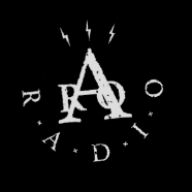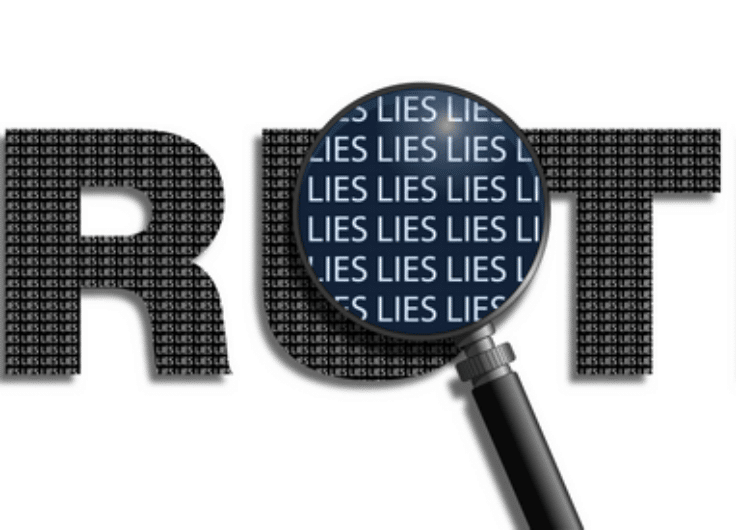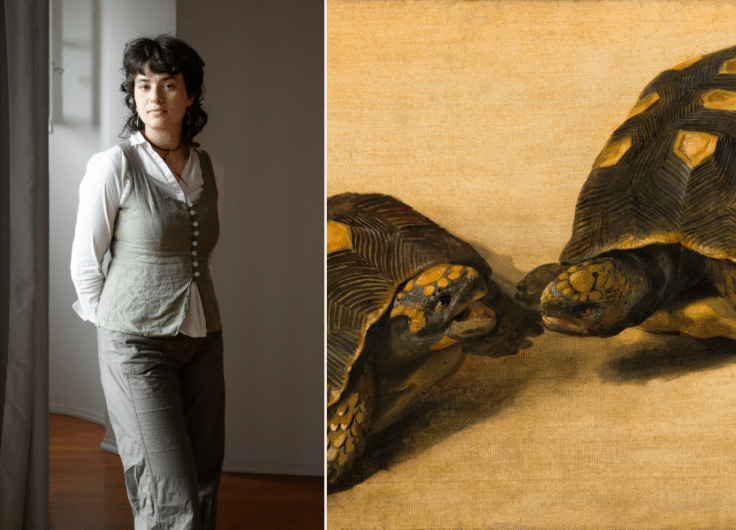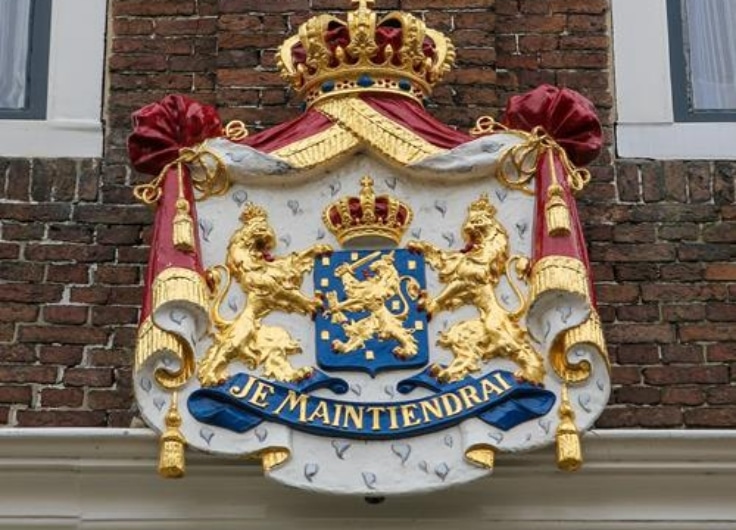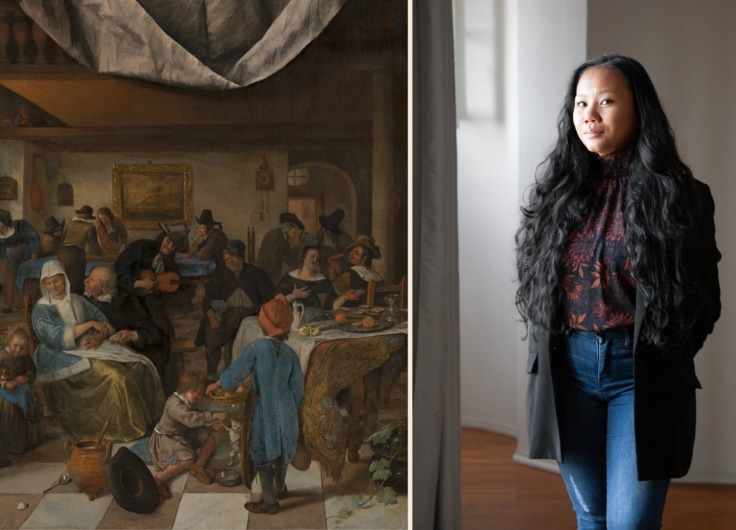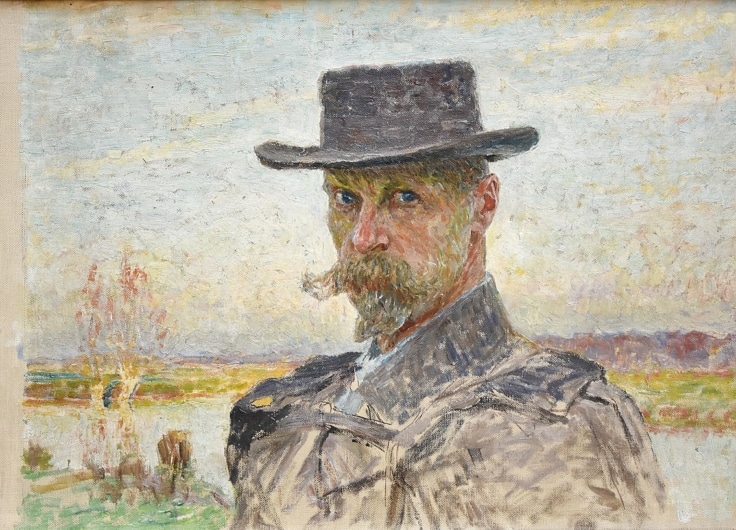On his deathbed in 1417, William VI, Count of Hainaut, Holland and Zeeland, named his daughter Jacoba of Bavaria as his heir. Given the financial, political, and military might of these three territories, this elevated Jacoba to an extremely powerful position within the Low Countries, and despite being only fifteen years old, she seems to have been up to the task. Unfortunately for her, however, being born a woman in a male-dominated society meant that her inheritance was constantly challenged.
At 22 months old Jacoba was betrothed to the French king’s fourth son, John of Valois. We covered this in the previous article of this series, and won’t go into it too much here, but already at not yet two years old she was a piece on the political chessboard. This was not unusual, and it also wasn’t just women who had their destinies so controlled in this social system. We’ve seen how marriage played such an important role in diplomacy and political agenda at the decision-making level of this society, and children of both genders had zero say in who they were expected to share a life with. After all, Jacoba’s father, William VI, who organised this engagement, was himself about twenty when he was married off to an eleven-year-old by the arrangement of his father Albert and his new father-in-law, Philip the Bold. But having powerful men wrangle over her destiny would continue to be a major theme throughout Jacoba’s life.
Jacoba and John, himself aged five, were sent off to Hainaut to grow up with her parents, in Le Quesnoy, and to learn how to be the future Count and Countess of Hainaut, Holland and Zeeland. In 1411 the betrothal was agreed upon by the Pope, and in 1415 the two were wed in the Hague, in great pomp and ceremony. For William VI and his wife Margaret, this had been a great move, as Jacoba was their only legitimate heir. Although there was precedent in Holland of a woman inheriting control of the territory, it had been met with resistance, so Jacoba being married to a male from a strong family who could rule alongside her assured the security of William’s legacy.
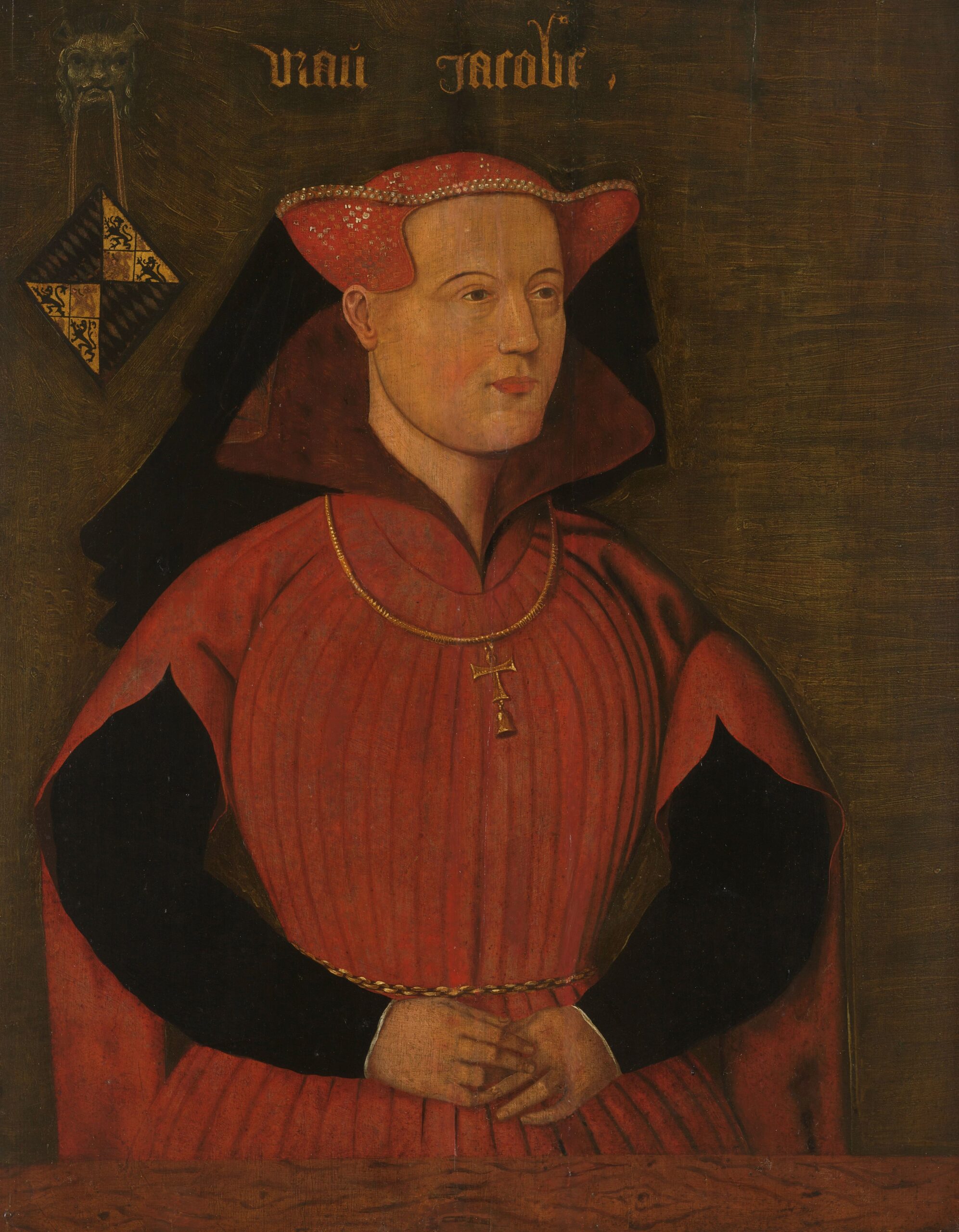 Portrait of Jacoba of Bavaria, Countess of Holland and Zeeland (Jacqueline, Countess of Hainaut), anonymous, after c. 1480
Portrait of Jacoba of Bavaria, Countess of Holland and Zeeland (Jacqueline, Countess of Hainaut), anonymous, after c. 1480© Rijksmuseum
Even though John was the fourth son, the fickle fortune of 15th-century filial fatality struck all of his elder brothers. Not even half a year after the wedding, he became the new dauphin; the heir to the French throne. And now Jacoba had a whole new path set out before her; she would be the Queen consort of France, and potentially mother to a future king. Needless to say, her parents were stoked. But alas, this was also not meant to be. In April 1417 her husband, dauphin John went too far in copying his older brothers and also died. So now, Jacoba alone held the rights to succession in Hainaut, Holland and Zeeland.
Imperial interest in Holland
The empire was interested in the fortunes of Holland for multiple reasons. At the beginning of the 15th century, Holland was on the rise. Immigration into the north of our swamp had accelerated the forces of urbanisation, increasing the labour force and allowing its mercantile systems to grow in strength. Holland was located close to Hanseatic networks, to Flanders and, as we went into a while back, was a hot spot for the growing herring industry and closely aligned ship-building industry. We know that in recent episodes we’ve been neglectful of the everyday people who make up most of a nation’s history. We’ve had to spend some serious time on the saucy and salacious and, therefore, more often told tales of in-fighting and in-breeding nobility, but we will soon get our boots back on the ground, and amongst the commoners of low country societies. However, suffice it to say for now, in Holland things were recovering from the devastation of the Black Plague with gusto, and its urban centres were starting to look like they might soon match those powerhouses of Ghent, Bruges and Ypres in Flanders.
The growth of Burgundian power had not gone unnoticed by the powers that be in the Holy Roman Empire. Even though the Burgundian dukes were massively entrenched in French politics, most of the Low Countries, including Holland, were still technically enfeoffed by the Emperor. Sigismund, playing at being ‘Emperor’ (which he would officially become in 1433), saw that with Jacoba succeeding her father, she might marry close to the Burgundian clan, and thus give them even greater control in Holland than they already had just through John’s alliance with William VI. So, Sigismund supported John of Bavaria aka the Pitiless. Although John the Pitiless had relied on John the Fearless to secure his rule of Liège via the battle of Otheé, the harsh terms that John the Fearless put on Liège afterwards had not sat well with the bishop-elect, so he pivoted towards leaning on the emperor instead of on his brother-in-law. John the Pitiless was a highly ambitious and, it turns out, politically shrewd animal.
William VI, for his part, continued trying to secure his daughter’s rights to succession in Holland and Zeeland, aware of his younger brother’s hungry, hungry eyes. Unfortunately, he never got to ensure this, because about two months after Jacoba’s first husband died, William came across an angry dog with an infectious bite and also died.
Contested inheritance
Instantly, John the Pitiless loudly contested her right to be the heir. John was supported by Sigismund: the for-all-intents-and-purposes Emperor, who claimed that with no male heir to Holland and Zeeland, ownership of all three territories should revert to the Emperor to do with as he pleased.
John the Fearless, on the other hand, took advantage of this situation by arranging for Jacoba to marry his nephew, John IV, Duke of Brabant in April 1418. Whilst this was mostly for his own Burgundian benefit, this marriage also would have helped Jacoba with her claims in Holland, because unfortunately for her, she was a woman in a man’s world. Her gender meant that she could not simply rely on her own sense of legitimacy, but had to have a powerful male who could muster an army on her side, in order to validate it.
But John the Pitiless wasn’t about to just let this happen. Immediately after William’s death, he had given up his claim to the bishopric of Liège. Assured of Sigismund’s backing, he went to Dordrecht, and stated that he was Jacoba’s legal guardian. Supported by the town’s leadership, he began appealing to influencers in other big towns. By the end of the year, John had been enfeoffed by Sigismund with the titles to the three counties being contested. He then powered up another level by agreeing to marry Sigismund’s niece and Anton of Brabant’s widow, the Duchess of Luxembourg, Elizabeth of Goerlitz. So now John the Pitiless was also the Duke of Luxembourg, and was ready to take over Holland and Zeeland properly.
Hook and Cod Wars
During an earlier succession crisis in Holland, factions known as the Hooks and the Cods had sprung up and engaged in on-again/off-again conflicts with varying degrees of violence. By the 1400s different towns in Holland showed different expressions of the factions; town populations and political bodies likewise reflected these differences. Citizens of Amsterdam aligned more with the Hook faction, whilst the international merchants there identified as Cods. Leiden had a Cod-leaning artisan faction, whilst the urban-elite were Hooks. So although people across Holland were lining up behind the names Hook and Cod, those people would not have necessarily agreed upon any one ideal or single purpose.
Even among the rulers of Holland, there were differences. Jacoba’s grandfather had leaned more towards the Cod faction, and even had a Cod girlfriend who had been murdered by his Hook opponents. His son, William VI, however, with his wife Margaret beside him, had waged war against the Cods, and spent his rule putting Hook partisans into administrative positions, rankling the sensitivities of Cod supporters in many towns.
So now with two men, both named John and both calling themselves the rightful Count of Holland and Zeeland, these factions began to line up behind them. John the Pitiless sought the support of the Cods, who held power in many of the bigger towns of Holland; the Cods took out their hatred of Jacoba’s father on her and her new husband John IV, and threw their weight behind him. Jacoba and John IV, in turn, looked to Hook members of the nobility for support, which she largely received. But this, of course, was not enough.
The prospect of a personal union between Holland and Brabant, via the marriage between Jacoba and John IV, was unwelcome to the Cod faction and hardened the support for John the Pitiless in the towns of Holland. The merchant and artisan classes in towns like Dordrecht, Rotterdam and Amsterdam didn’t want their commercial potential stifled by the already strong trading Brabantine towns, like Antwerp and Brussels. John the Pitiless in Dordrecht used this discontent and continued rallying support and arms with which to further his claims. Jacoba, now wed and based in the Brabantine court in Brussels, had the support of many of the States of Hainaut and Brabant, but because of her physical absence in Holland was unable to court Hollanders as successfully as her uncle was. John the Pitiless had taken a leaf out of the Burgundian playbook, and became an active patron of the arts, promoting a court culture of which Hollanders could be proud; simultaneously promoting the glorification of Holland, and building a system of relationships with various power brokers across the territory.
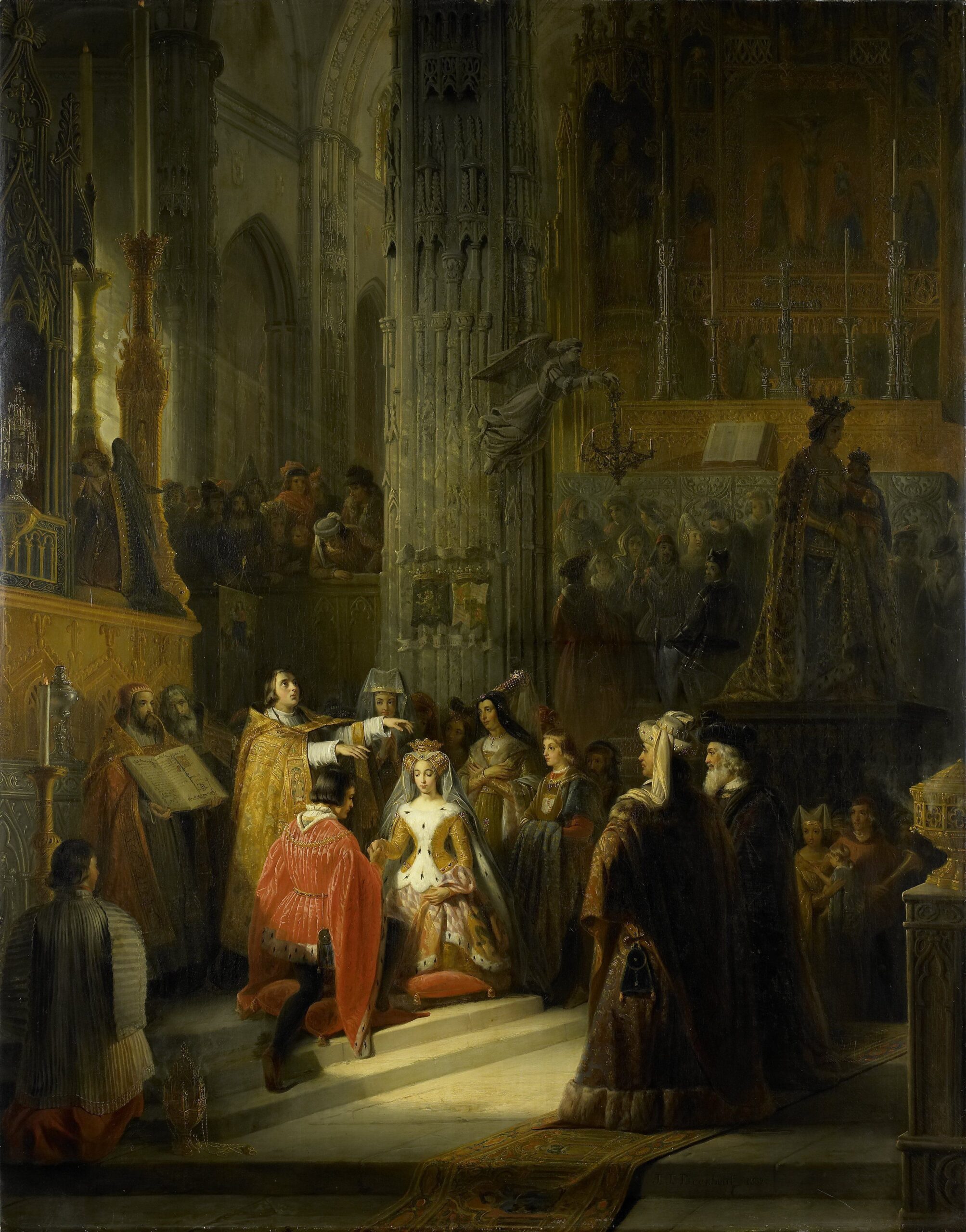 The Wedding of Jacoba of Bavaria, Countess of Holland, and Jan IV, Duke of Brabant, 10 March 1418, by Jacob Joseph Eeckhout, 1839
The Wedding of Jacoba of Bavaria, Countess of Holland, and Jan IV, Duke of Brabant, 10 March 1418, by Jacob Joseph Eeckhout, 1839© Rijksmuseum
Marriage of misery
The marriage between Jacoba and John IV was an extremely unhappy one, and John IV would not go down as a great ruler. He had a lethargic disposition, and preferred doing things like hunting, rather than governing. He was also saddled with debt which he would never shake off. To his credit, he did make initial attempts to help his wife in her efforts against her uncle and the Cod faction in Holland. Hainaut armies were mobilised, and the second round of the Hook and Cod Wars kicked off. John the Pitiless enjoyed initial victories in battle, and succeeded in taking Rotterdam in 1418 with the help of Cod forces.
Apparently, when it came to battle, Jacoba could be an inspiration on the field whereas John IV was the opposite. Take this with a massive grain of salt, but an English writer in the 1817 Gentleman’s Magazine and Historical Chronicle, Vol 87, described her excellently, and we will quote this description, if only for the use of one of our favourite words: He said Jacoba …
‘…took to the field at the head of her troops of Hainaut, and performed prodigies of valour, which were rendered ineffective by the pusillanimity of her husband, who spread dejection and dismay amongst the ranks of the Brabanters.’
To make matters worse, the marriage was controversial at the time due to, wait for it, how closely related John IV and Jacoba were. Yes, it seems bizarre to us too that in a time of wanton inbreeding, people were unhappy about cousins getting married, but such was the case. Although the pope in Italy had granted dispensation for this marriage, it was retracted weeks later upon request by Sigismund, meaning the validity of the marriage depended on who you asked. John the Pitiless used this uncertainty to his advantage, now being able to tell people how much the pope agreed with him that John IV had no claim to Jacoba’s lands, because their marriage wasn’t real. At every level of her life decisions were being made for Jacoba by other people, all acting in their interests, and now she had ended up with her lands and titles being taken from her by a pitiless uncle, and to make matters worse, to defend those lands and titles, she had to rely on her disputable marriage to a man who was a useless coward.
Philip the Good and the Treaty of Woudrichem
Philip and his father John the Fearless had largely managed to avoid the kind of revolts that had long stricken Flanders. Whereas John had grown up in the French court, had been the son of the French regent and had taken his responsibilities in France as a priority, Philip did not. His concern, from early on, was more about Flanders than France, and as always, the greatest point of interest for Flanders was maintaining relations with the English. At this point, England had become extremely powerful, and after the battle of Agincourt English Lancastrian forces had gained a sturdy foothold in France, essentially controlling the middle of the country.
When it came to the ongoing issues in Holland between Jacoba and John the Pitiless, Philip tried to maintain the status quo, and attempted to mediate to the benefit of John IV and Jacoba, generally trying to avoid warfare. However, John IV was a damp squib of such great pusillanimity, that he could not match John of Bavaria in their negotiations. He was pushed around, and in early 1419 the result was the Treaty of Woudrichem. Its conditions show just how little John IV fought for the claims and dignity of his wife. The treaty allowed her uncle to maintain possession of the land he already controlled, which included the two great towns of Dordrecht and Rotterdam. She would have to share power with him over all her territories for five years, and
to name him as her heir. John IV would then be put further into debt, by agreeing to pay an indemnity to John the Pitiless of 100,000 gold coins. This greatly angered the states of Brabant, who themselves were divided between favouring a Burgundian alliance through John IV or an imperial one through John the Pitiless. Now the people of Brabant were going to have to front up money for this fine.
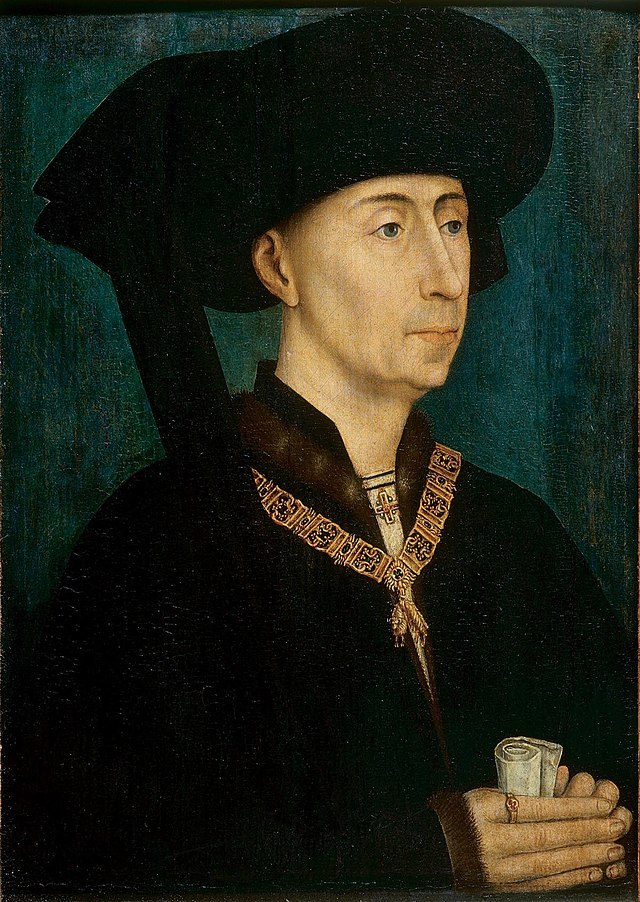 Portrait of Philip 'the Good' of Burgundy (1396-1467) by Rogier van der Weyden, ca. 1455
Portrait of Philip 'the Good' of Burgundy (1396-1467) by Rogier van der Weyden, ca. 1455© Wikimedia Commons
Jacoba refused to acknowledge the terms of the treaty. She’d had no say in its terms and had been represented by someone who did not have her interests at heart. She continued her resistance to the encroachments of her uncle, with the support of the Hooks in Holland and about half of the States of Brabant.
Then, in September 1419, the Burgundian world changed. That fateful meeting on the bridge at Montereau between John the Fearless and the Dauphin Charles ended with the Duke of Burgundy’s body being left strewn, slashed, smashed and stabbed to smithereens across the surface. His land and titles were transferred to Philip.
Philip’s first steps as Duke of Burgundy, would set him on a decisive path throughout the rest of his life. Instead of taking immediate, violent vengeance on the dauphin or the Armagnacs who had killed his father, Philip took stock of the situation. His chances of successfully taking his place as a prince of the blood in the French court would have looked slim indeed, given that the Dauphin’s court in Bourges was by now basically running the show. Philip realised that his fortunes lay not in France, but to the north and east of Flanders. Philip took the identity of Burgundian dukes and pivoted it from being one of the loyal French princes, to becoming one inextricably linked with the low countries.
So, whereas his father had steadfastly held his French prince-ness in check when it came to allowing for an Anglo-Flemish trade agreement, Philip actively sought an alliance with the English, and also with Queen Isabeau, who had seen her power amongst the Armagnacs fall. This led to the Treaty of Troyes, signed in May 1420, in which she named the English king Henry V, who had so successfully invaded five years earlier, as the regent of the mad Charles VI and heir to his crown. France was now divided into three. Dauphin Charles ruled the Southeast, Henry V the northern half from west to east, except for the Burgundian territories which were ruled by Philip himself. It would be so interesting to know what Philip’s grandfather, namesake and loyal French prince, Philip the Bold, would have thought of this move. The younger Philip had handed much of France, including its capital, over to their greatest enemy. However, he was also reaping the rewards in the Low Countries for what the older Philip had started to sow all those years ago. And those rewards would only increase.
The flight of Jacoba
Things continued to get worse for Jacoba. In April 1420 John the Pitiless backed John IV of Brabant into another diplomatic corner, and had him sign the Treaty of St Maartensdijk, in which he mortgaged Holland and Zeeland to John the Pitiless for 12 years. John IV also left the Hook faction and took up a role with the Cods, abandoning his wife. This was extremely unpopular amongst many people, including the States of Brabant, who now saw that their duke did not have a backbone, and began making moves to limit John IV’s power before he caused the duchy irrevocable damage. Jacoba was furious with her husband. Confined to the Brussels court, she was now married to a man who was actively working against her.
This betrayal was just the latest in a long list of grievances Jacoba held against her husband. Earlier in that month, in a move indicative of a psychologically and emotionally abusive relationship, John IV kicked some of Jacoba’s ladies-in-waiting out of the dining hall and, according to his secretary Edmond de Dynter, put limits on the amount of soup she was allowed to eat and wine she was allowed to drink. It is clear that the marriage was unhappy on both sides, and that beyond the political betrayal, they just also had a terrible relationship with each other.
Jacoba called her mum from Hainaut who came to Brussels to try and mediate the situation. Margaret was still mostly concerned with the maintenance of her daughter’s position of power, so when a conciliatory response was not forthcoming from John IV, Jacoba and Margaret packed up her stuff and bailed on April 11, 1420. She left Brussels and went home to Hainaut to continue her fight for Holland against her uncle. Jacoba now showed her adeptness at identifying political weaknesses and other points she might exploit that to aid her cause. She did this by leaning on the revoked validation of her marriage by the pope, leaving her husband and casting off the personal union with Brabant. She now had to consider where to look next for support and cast her gaze towards England. Jacoba saw how their interests on the continent could be aligned with her own in the Low Countries and began corresponding with the English king.
Team England
Across the major Low Countries things looked incredibly unstable. The States of Brabant had learned that their duke was incompetent and came down hard upon him and Holland was divided by civil war, allegiances to Jacoba or John the Pitiless split across towns and regions. From June to August of 1420 Leiden was put on siege by John the Pitiless’ forces, and when it fell to him Jacoba lost another important town to her cause.
When Jacoba entered into communication with the English king, the level of instability turned up a notch. The prospect of England increasing its holdings in the continent was not a happy one for any of the other major parties involved. Although he was allied with the English, Philip did not want to be flanked on both sides by them and did his best to reconcile John and Jacoba, but to no avail.
Things came to a head on 6 March 1421, when Jacoba took drastic action and left for England. Her correspondence with the English king had paid off, as he gave her full support while she was there. Jacoba still badly needed a husband with an army to defend her holdings. John IV had proved useless and so now Jacoba turned 180 degrees and now agreed with her uncle and the pope that her marriage to him was not valid. The magnitude of this act and the importance of what political consequences arose with an un-married Jacoba, can be seen in the frantic level of communication happening between Philip and a ton of other people about it, in England, Brabant, and Holland. He had allied with the English to give them power in France, but he had no interest in them taking control of territories north of him, in Hainaut, Holland and Zeeland. If Jacoba did something like elope with a powerful English prince, this is exactly what could happen. Speaking of eloping, that brings us to this week’s “bet you didn’t know that was Dutch”. The word elope derives from the Dutch word “ontlopen” which means to run away. So Jacoba had ontloped the hell out of there, and provided us with a tidy little ‘bet you didn’t know that was Dutch.’
Jacoba was welcomed into the English court with honour and dignity by Henry V, who was back in England for a short respite between battling in France. Henry was no fool and had identified in Jacoba the exact opportunity about which Philip was so concerned. He quickly arranged for her to marry his brother, Humphrey, Duke of Gloucester. Henry then returned to France where he died suddenly in August, leaving an infant son and an inevitable power struggle behind him. Jacoba and Humphrey were married in October, but once again, the pope in Rome put on his big hat and his red shoes, waved his magic wand around said “sorry, not married”.
Although the Great Western Schism of the Church had finally ended in 1414, and the Avignon papacy was no longer, Benedict the XIII was still alive, hanging out in Spain and still calling himself pope, and he agreed to give them the necessary go-ahead. These were strange times indeed. Suffice it to say that this third marriage was even more disputed than her second had been, and that had been incredibly disputed. Nevertheless, Humphrey of Gloucester began calling himself Count of Hainaut, Holland and Zeeland, which now, alongside John IV and John the Pitiless, made three blokes at that point claiming those titles, all via guardianship of their actual owner, Jacoba.
St Elizabeth’s Day flood
In November 1421, while Jacoba was in England, a huge portion of the land she was busy trying to reclaim fell victim to the 20th worst flood in history. The St Elizabeth flood affected Flanders and Zeeland, as well as parts of Friesland and Denmark, but the greatest devastation was in Holland. The polders around Dordrecht went under, as a great storm came in from the northwest, followed by a huge storm surge. The dikes were breached, and entire villages, alongside at least 2,000 and possibly up to 10,000 people, were swept away. Lands that were submerged in the flood have never been recovered, remaining underwater into modern times. It was this flood which created one of the most beautiful landscapes in the Netherlands, the wetlands known as the Biesbosch. From that point on, many Hollanders were too busy dealing with the devastation of inundation, in addition to dealing with the civil war that had erupted.
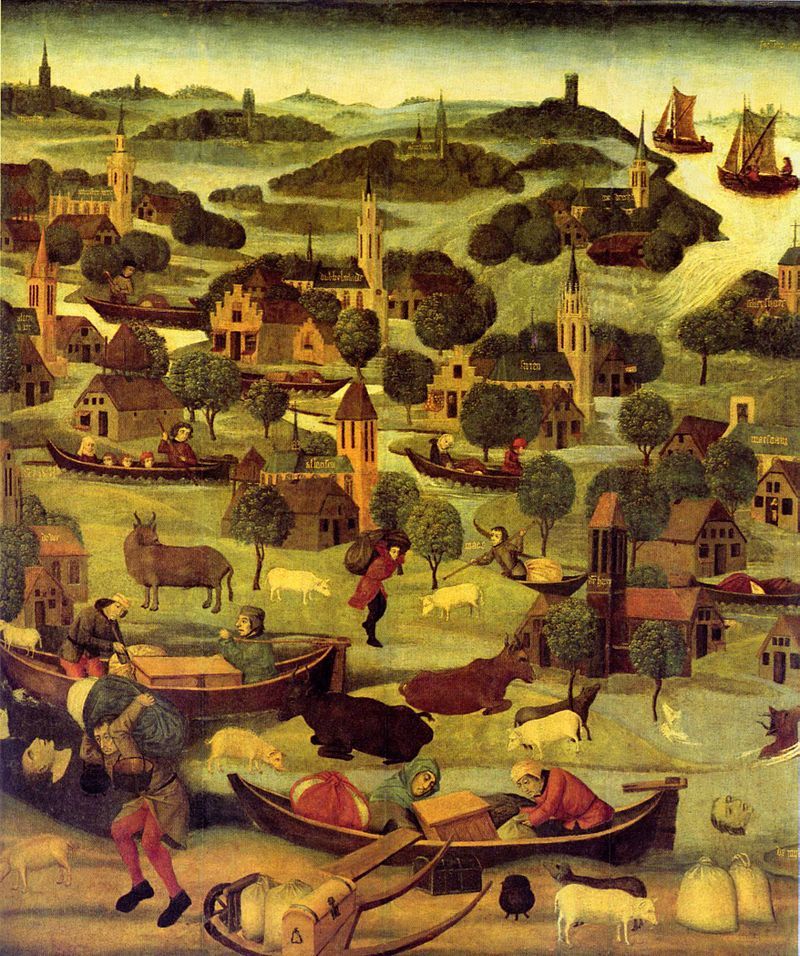 St Elizabeth’s Day flood, 18-19 November 1421, by the Master of the St. Elizabeth Panels, ca. 1490-1495
St Elizabeth’s Day flood, 18-19 November 1421, by the Master of the St. Elizabeth Panels, ca. 1490-1495© Rijksmuseum
Easy expansion
Across 1420-21, an opportunity fell in Philip’s lap to increase his holdings in the Low Countries. It came in the form of Namur, a small territory which borders Liège, Hainaut and Brabant. Its count, John III, was childless and broke. He came to Philip with an offer to sell the inheritance of Namur to him for 132,000 golden crowns, a huge amount. It is unclear how great Philip’s ideas of expansion were at this early stage in his rule, but the acquisition of Namur, which would pass to him whenever John III died, would increase his holdings and give him a valuably strategic position on the border with Brabant and Hainaut.
Philip already had a lot of influence in Brabant. Burgundian policy for years had been to keep as many members of the Estates of Brabant in their pocket as possible. The Brabant Estates were divided, but also moving towards taking full control of the government in Brussels. With the rebellious flight of Jacoba, Philip saw the opportunity to curry his favour amongst them as he considered making another major political move.
Philip had been in frequent contact with John the Pitiless over the years, and in 1424, put off by Jacoba’s English dalliance, swayed him away from the imperial influence of old Sigismund, and onto his side. In April, John the Pitiless and also childless, named Philip the heir to his possessions in Holland and Zeeland. This was huge for Philip, because now his name was also officially on the list of people with a claim on these territories, and now he would just have to get past two people and he would jump to the front of the queue. It was also huge for Jacoba, because she had now lost all support of her very powerful and very ambitious Burgundian cousin.
English intervention
Rumours began circulating around July 1424 that Humphrey and Jacoba were assembling a great invasion force that would soon be on its way to ravage the region and that she was pregnant with his child. Although the pregnancy ended in a stillbirth, the invasion did happen, when Jacoba and her husband landed at Calais at the head of a force in mid-October. They intended to take over Hainaut, which in Jacoba’s absence was being ruled by the other man who claimed to be her husband, John IV of Brabant. Philip played it cool and did not send an army against them at first. By the end of December, Hainaut was back in Jacoba’s hands, although she lost a lot of support in Hainaut, Brabant and Holland for the fact that she had allowed an English army into the Low Countries.
It was at this point that Philip reverted to a military approach, and began mobilising troops for an assault on Hainaut. It has been argued that he deliberately delayed action to allow John IV’s weaknesses to be fully exposed, thus enabling him to take as much control of Hainaut for himself as he could.
It was at this point that fortune once again shined upon a Duke of Burgundy, when John the Pitiless, entrenched in Holland as its effective ruler, died. As to how this happened, well the story goes that he had come into a disagreement with the husband of one of Jacoba’s bastard sisters, a guy called Jan van Vliet. Van Vliet had decided to take action, and had smeared a slow-acting poison onto the pages of the prayer book used by John the Pitiless. This conspiracy was discovered, van Vliet was captured and tortured, whereupon his confession brought the plot to life (because we all know that confession under torture is ridgy-didge) and he was promptly beheaded. Unfortunately for John the Pitiless, more was the pity, as the poison was unstoppable and caused him six months of pain before he took to shaking off his mortal coil. Revenge from beyond the grave, spooky.
Philip, who was in Burgundy at the time, and having attained the succession rights to John the Pitiless’s holdings, now became the nominal head of the Cod faction in Holland. He began the process of “Burgundianisation” in Holland and Zeeland, moving people loyal to him into places of administrative power and building up a clientele of supporters. He compelled John IV of Brabant, who was still pretending to be Count, to accept him as a partner in the administration of the counties, and joined his troops with the Brabantine forces fighting for the weak Duke of Brabant. In March 1425 they crossed into Hainaut and put the town of Braine-le-Comte under siege. After a few days, the English garrison there surrendered. The Duke of Burgundy then offered the Duke of Gloucester a chance to end the war before it erupted further, by challenging him to hand-to-hand combat. This was a pretty bold move, and it paid off. Humphrey accepted the challenge, and a great fervour surrounding it began to spread across Europe. Unfortunately, before this mano-a-mano could happen, Humphrey packed up his stuff, grabbed one of Jacoba’s ladies-in-waiting, Eleanor Cobham, with whom he had fallen in love, and buggered off back to England. Jacoba was left floundering in the town of Mons, once more betrayed by the fact that she always needed to rely on other people, and those other people always looked after their interests first.
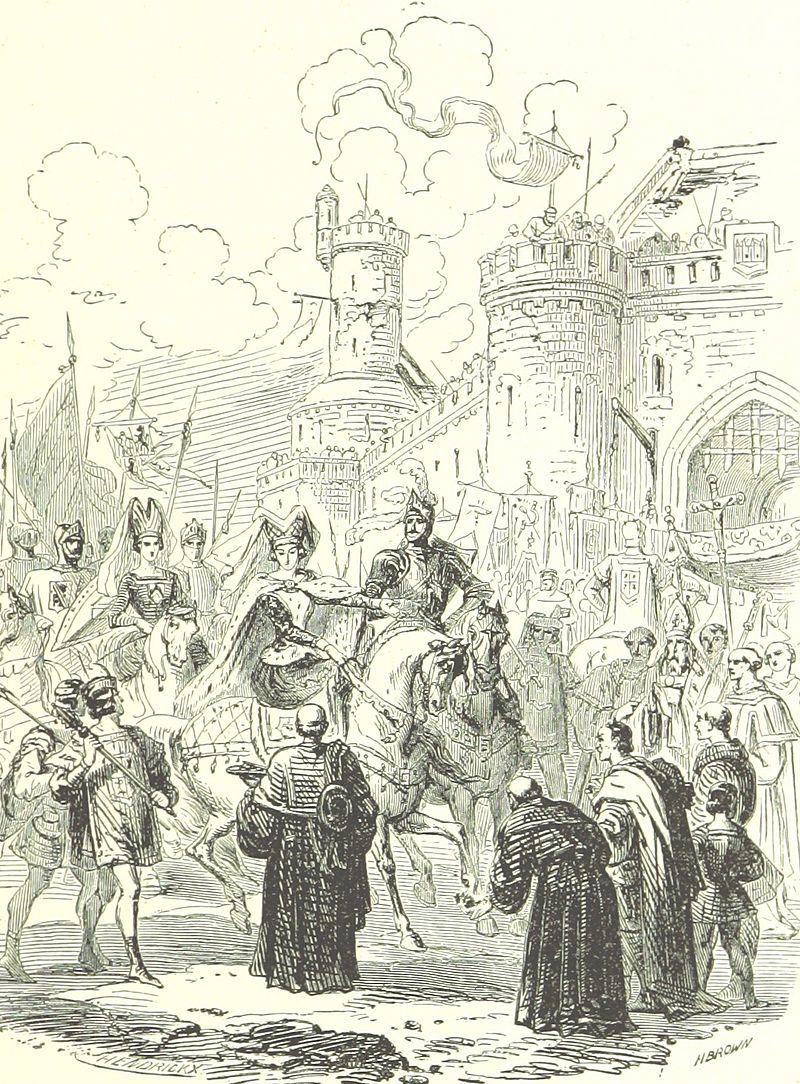 Entry into Mons of Jacoba, Countess of Hainaut and her new husband Humphrey of Lancaster, 1st Duke of Gloucester, Image taken from Illustrated History of Belgium, 1885
Entry into Mons of Jacoba, Countess of Hainaut and her new husband Humphrey of Lancaster, 1st Duke of Gloucester, Image taken from Illustrated History of Belgium, 1885© Wikipedia
Philip proceeded with a firm but diplomatic approach towards Jacoba. There was unrest against her in Mons, and many of the power brokers there had been indignant at the involvement of the English and were keen on Philip. At the same time, Philip made John IV give up control of Holland and Hainaut, making John’s total loss of power complete. Jacoba was still convinced that Humphrey would return but when her appeals to him were met with silence, and with the pressure bearing down on her from inside and outside of Mons, in the middle of 1425 Jacoba surrendered to her cousin, Philip. She was taken to Ghent, where she was put under house arrest. Philip was now in control of the Burgundian lands, Flanders, Artois, Hainaut, Holland and Zeeland, and was also the puppet master of Brabant. But he wasn’t done yet.
Escape, and to continue the war
In September 1425 Jacoba was due to be moved from Ghent to Lille. Instead, she contrived to dress as a man and, in the early and dark hours of the morning, passed furtively through the streets of Ghent, got outside the city gates to where two of her knights were waiting for her and they helped her escape successfully to Antwerp. From there Jacoba got on horseback and rode as quickly as possible to Gouda. Philip was not going to take her land from her without a fight.
In Holland, she found active support. Sure, many people had backed John the Pitiless, but he was now dead. Those people did not necessarily wish to see the expansion of Burgundian power into Holland, and in Jacoba they saw a rallying symbol of independence against that happening. She raised an army, and went to war once again.
Philip went into overdrive when Jacoba escaped. He was not sure where she had gone, and feared another English intervention on her behalf. Soon he was raising his banners, receiving pledges of allegiance from towns in Holland that were loyal to him, and sending back garrisons, as well as some of his best military captains to prepare for the defence of Holland. He sent spies everywhere, trying to learn as much as he could about where Jacoba was and what she was planning. And before long he was in Leiden himself, leading the campaign. On the 22nd of October a contingent of militia from Amsterdam, Haarlem and Leiden was sent towards Gouda, where she was headquartered. She and her forces jumped them, near Alphen in South Holland, and handed Philip a heavy defeat. He now had to personally go and rally the towns of Holland who were with him, fearful of the image of Hollandic liberty that Jacoba was starting to represent. He did a tour of Holland to try to counter this, in the typical Burgundian style of laying it on very thick.
Jacoba’s marital status at this point was still up for debate. Philip of Burgundy had sent to the pope for a final ruling on the matter, but at this stage, Humphrey could still make a somewhat legitimate claim on Hainaut, Holland and Zeeland. According to a letter from Philip himself, in January 1426 a combined English and Hollandic force of about 1500 men turned up near Zierikzee in Zeeland, intent on making landfall and taking the fight to the Duke of Burgundy. Philip tells how he quickly left from Leiden to Rotterdam, from whence he and his forces, made up mainly of men from the Hague, Dordrecht and Delft, got on ships and set off to find the enemy and make battle at sea. They encountered a force of about 300, killing or capturing them, and then found the main body already disembarked at Brouwershaven. Philip put a blockade on them, as the conditions were too windy for him to make landfall, and a stalemate ensued for a few days. One anonymous chronicler referred to by Richard Vaughn notes how the people of the nearby Zierikzee took the opportunity to make money, selling provisions to both sides as they stayed glaring at each other.
When conditions were right, Philip had his forces disembark and prepare to attack. Before they could all make landfall, however, the enemy attacked Philip’s forces. He reckoned that he had about 4000 troops, of which a third was still on their ships. The English side, accompanied by about 3000 Zeelanders and some Hollandic nobility, were said to have been about the same in total. Although the English had the advantage of all being on land, the Burgundian forces included famed gunners from Dordrecht, who were able to set up and push the assault back. Crossbow and long-bow fire was exchanged before a heavy cavalry including Philip himself was able to make a dent in their line. Soon the force sent by Humphrey was being pushed back along dikes and into the sea, where many drowned. The result was a resounding victory for Philip in which few of the vanquished escaped.
From that point on Jacoba would find no further support from England. She would now need to rely on her own people. Most in Zeeland threw their support behind Philip, but many towns in Holland still saw him as a foreign threat, and so either stayed or became loyal to Jacoba. Indeed, some places, like the towns of Amersfoort and Alkmaar, and also the neighbouring bishopric of Utrecht, even switched sides to her at this juncture. So despite Philip’s resounding battlefield victory against the English in Zeeland, the war carried on.
In April 1426, Jacoba’s forces once again met with Philip’s in Alphen, and again handed them a heavy defeat. She then laid siege to Haarlem. Philip responded by targeting the location where her fleet was moored, by the island town of Zevenbergen. He put Zevenbergen on the siege in the latter half of 1426 and patiently waited for its fall.
Jacoba, meanwhile, made a last-ditch plea to England for assistance. This formidable woman, who refused to give up, still had to figuratively prostrate herself before those on the English privy council, including her estranged husband Humphrey:
‘Most noble, very reverend fathers in God, my most honourable lords and special friends…concerning my desolate self be pleased to know that I am in reasonable health but, on the other hand, in great anxiety, fear, danger and grief.’
She tells them she is sending the letter to
‘…refresh your most noble memories and to bring to your notice the monstrous outrages, oppressions and injuries which my cousin of Burgundy has perpetrated against me in the last two years in pursuing me from one of my countries to another in order to disinherit me, and in cruelly spilling the blood of my poor but loyal subjects.’
Her final paragraph of the letter reaffirms the difficulties of her position, not least of which because of the one condition that had held her back her whole life: that she was a woman born into a world ruled exclusively by men.
‘…I cannot endure without your help and my husband’s…So I, a poor disconsolate woman, entreat you most humbly that it please you to consider this matter sympathetically.’
But the English Privy Council, ruling in the regency of an infant, was not to be swayed. This was also largely due to the work of Philip. The man in charge of the English holdings in France, John Duke of Bedford, was a brother of Humphrey, but also had a close relationship with Philip. He knew how vital the Burgundian-English alliance was to England’s position in France. He and Philip had worked together for years in dissuading Humphrey from helping Jacoba, and this had finally paid off. By the middle of 1427, Philip did not have to worry about English intervention, although rumours of such would still occasionally persist.
Over four months Philip employed continual heavy bombardment of Zevenbergen, the situation for those living in the town growing steadily worse each day. Finally, the hungry citizenry overpowered the Jacoba’s garrison there, and opened the gates to the Duke of Burgundy.
Philip, having succeeded in crippling Jacoba, now needed to finish the job. With the loss of her ships, her ability to supply herself and her army was severely hampered. But Philip knew that the towns of Holland had plenty of waterways by which they could move goods. He needed to stop this effectively, and also make clear to those standing against him in Holland that he was not somebody to be defied.
Philip went to Amsterdam around Easter of 1427, and there commanded the town to build a 20m long defensive boulevard along the sea face, protected by walls reaching about 5m high and thick enough to withstand cannon fire. Having done this, he then had them construct a defensive barge blockade, which could be used to prevent goods from being shipped to Utrecht or Amersfoort. This was an extremely unique piece of military hardware, and also just a very loud statement to the people of Holland. Philip the Good had arrived and he was not going to go anywhere.
Which was a real shame for Jacoba, especially when, in April of 1427, her ‘depending-who-you-asked’ husband, John IV of Brabant died. Now she was the only remaining contestant from the original kerfuffle alive, and the titles of Hainaut, Holland and Zeeland all reverted to her. John IV’s younger brother, Philip of St Pol became the new Duke of Brabant and Limburg. Philip did not care one jot. Even though his administration of Hainaut, Holland and Zeeland had been technically made void by John IVs death, his goals and ambitions were clear and he would not be swayed by technicalities.
By May 1427 Philip was confident enough to declare the war over, but obviously, he did not tell Jacoba. Although she had been massively curtailed, she was not defeated. She never lost her most ardent supporters, chiefly in Gouda, and she had gained the support of the prince-bishop and people of Utrecht, whose own civil conflict had merged with that of Holland. Her remaining fleet, led by the capable Willem van Brederode, still had uncontested control of the Zuiderzee.
Although she was not going to lose the war, it was clear that without any further help from the English she wasn’t going to win it either. In late 1427 Philip arrived in North Holland to begin a winter campaign that would see mixed results. His navy defeated and captured van Brederode, and made gains towards Utrecht to try and replace the Jacoba-allied prince-bishop. Philip’s objectives met opposition amongst the people of Utrecht, and beyond establishing positions near Naarden and Harderwijk, he was unsuccessful in pushing further than Amersfoort. Imagine being stuck in Amersfoort. By the end of January, he was forced to withdraw altogether.
But in early 1428 Jacoba’s hopes were dealt a mortal blow. Remembering that her marital status was still entirely unclear – depending on who you asked she was either the widow of John IV or the wife of Humphrey of Gloucester – the pope had been asked for a final decision, and he now declared her marriage to Gloucester to be have been invalid, and now null and void. Her risky move to make a personal union with an English prince had finally failed. In spring, Philip laid siege to her base of Gouda, and by July Jacoba recognised that the writing was on the wall. On the 3rd of that month, she formally surrendered to Philip via the Treaty of Delft. By the terms of this agreement, she retained her titles, but effectively ceded the administrative rule of her lands to Philip.
One man to rule them (almost) all…
Jacoba, it would seem, was defeated. In 1429 an agreement at Valenciennes confirmed that she would receive an annual sum of 24,000 pounds, but had to give up all administrative rights in Holland, officially making Philip the regent and heir of Hainaut, Holland and Zeeland. Also in that year, John III of Namur died, and so due to their earlier agreement Philip inherited that territory too. His domains expanded again in 1430, when Philip of St Pol, the Duke of Brabant, also died, having also left Philip as his heir.
Philip though, in a pragmatic fashion, realised that the difficulties of running a large, centralised state, combined with Holland’s vulnerability to civil divisions and conflict, would cause him problems. Instead of ruling Holland directly, he just continued to put Burgundian loyalists into different positions and then in 1430 sold an eight-year lease of the rule of Holland to the Lords of Borselen, including Frank van Borsele, who had earlier been appointed General and Grand Captain of Zeeland.
And this would seem to be the end. Jacoba was broke and had been stripped of all power. Philip had won. Right? Well, Philip obviously didn’t think so. He quickly grew threatened by the growth in power of Frank van Borsele and had him imprisoned. Then he forced Jacoba to come to the Hague and ‘voluntarily’ abdicate all her titles, in so doing recognising Philip as the Count of Hainaut, Holland and Zeeland. Once she had done this, Frank van Borsele was released. A legend soon grew up that Jacoba had earlier secretly married van Borsele, and this had prompted Philip to make these moves, but this is highly speculative.
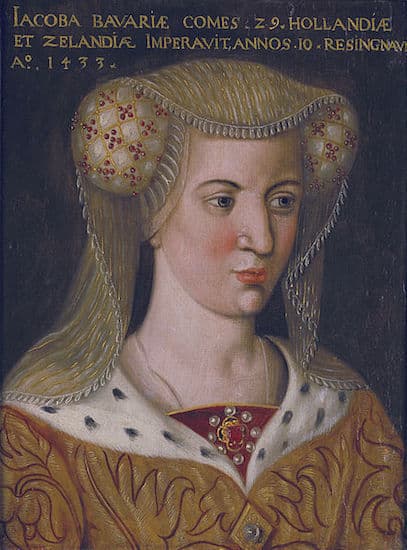 Dutch School, Jacoba of Bavaria, c. 1600
Dutch School, Jacoba of Bavaria, c. 1600© Hague Historical Museum.
Curiously enough, though, the two did get married later, and this time with Philip’s blessing, in 1434. They retired to live on meagre lands Philip had left to her in Zeeland. No scholar since has been able to rule out that the marriage was one of love, although Richard Vaughan makes the statement that it was not long before they were fighting with each other. Whatever the truth in this regard, Jacoba would not long enjoy the quiet, married life as the wife of a rich nobleman. In 1436, at the age of 35, she died of tuberculosis. And that, somewhat tragically, was to be the lot of Jacoba of Hainaut.
The sources on Jacoba’s personality are scarce and, due to the political turmoil in which she found herself embroiled, undoubtedly tainted by bias. She was said to have been fiery, passionate and inspirational, but it is impossible to know for sure. Furthermore, her life and character have been recycled through Dutch history in different forms and for different purposes. What we found interesting is how her life exhibited the stark differences in challenges faced by males and females born into ruling positions. Had she been a man we would have been talking about Jack I of Holland. Given her gender, and because of the culture of feudal jostling for power, she was used her entire life as a political pawn by her father, her uncles, the king of England and then her cousin. She ended up being married four times, perhaps once happily. She raised an army and invaded the Low Countries from England, which not many people can tick off their bucket list. Whatever she was really like as a person, what cannot be said of Jacoba is that she did not give struggle for what she believed in, because she did and it took everything that Philip the Good had to finally defeat her.
Behind her was left the one person you’d have to say came out as the victor in all of this: Philip the Good; the grand-son of Philip the Bold whom; he who, all those episodes ago, we mentioned would come out ruling the entirety of the Low Countries. By the mid-1340s he was just about there, and it is here that we will leave him, in charge of Burgundy, Flanders, Rethel, Nevers, Artois, Brabant, Holland, Zeeland, Hainaut and Namur.
Sources
- Chronique des choses de mon temps, a history of the years 1417–74 by Chastellain (and Minolet)
- Les Livres des Trahisons de France envers la maison du Bourgogne (anonymous)
- Holland, County and Province of by Hugh Chisolm
- Governmental Forms and Economic Development: From Medieval to Modern Times by Maria Brouwer
- The Gentleman’s Magazine, and Historical Chronicle, Volume 87, Part 1, p. 197
- Philip the Good: The Apogee of Burgundy, Volume 3 by Richard Vaughan
- Geschiedenis van het Nederlandsche volk. Deel 1 by P.J. Blok
- Rural Space in the Middle Ages and Early Modern Age: The Spatial Turn in Premodern Studies by Albrecht Classen
- The Artillery of the Dukes of Burgundy, 1363-1477 by Kay Douglas Smith, Robert Douglas Smith, Kelly
- The Promised Lands by Wim Blockmans and Walter Prevenier
- Magnanimous Dukes and Rising States: The Unification of the Burgundian Netherlands, 1380-1480 by Robert Stein
- A History of the Low Countries by Paul Arblaster

